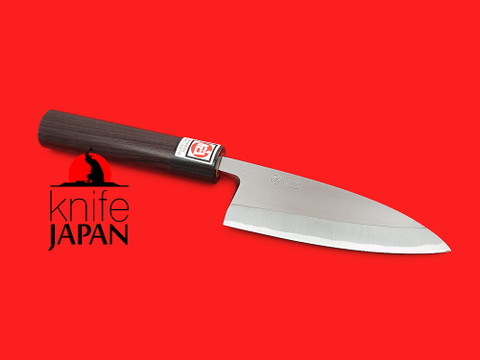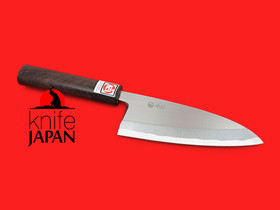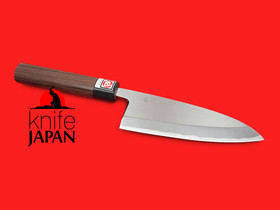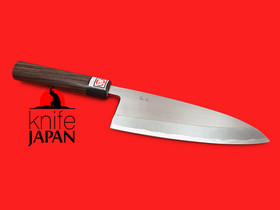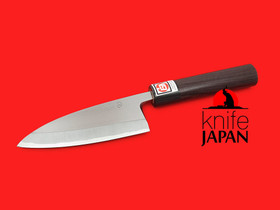Product Description
Ikenami Hamono is based on Tanegashima island off southern Kyushu in far west Japan, surrounded by deep sea. Their knives have a loyal following of industry professionals the length of the country.
Tanegashima knives are referred to as tanebocho and they are widely known for their high quality. There are four kataha deba knives in the Ikenami Hamono range, with blades of 13cm, 15cm, 18cm and 21cm.
The 13cm deba is short, beefy and sharp. This is a professional-grade deba that is as beautiful as it is functional, very effective at opening and trimming the small fish that usually arrive in bigger numbers.
Ikenami Hamono also produce a 13cm black-forged double-bevel deba at this length. Easier to sharpen and a significantly smaller investment.
| Blade steel: | YSS Shirogami #1 | nantetsu |
| Bevel: | Kataha single bevel |
| Blade construction: | Ni-mai awase |
| Left-handed available: | Yes |
| Handle: | Shitan (Red Sandalwood/Rosewood) |
| Ferrule: | Water buffalo horn |
| Blade length: | 130mm |
| Blade height: | 48mm |
| Blade spine: | 7mm |
| Handle length: | 121mm |
| Handle thickness: | 27x22mm |
| Weight in hand: | 198g |

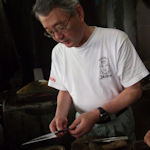
Product Reviews
-
Great, sharp, well-finished deba
Posted by Dean on 5th Dec 2020
A deba is the japanese fish filleting knife. These can be two main ways: to take off the head and cut it into small pieces for stew or stock, and the more important purpose, to remove the fillets from the bones.
This size is really nice because its small . . . enough that I have great control and feedback so its easy to cut close to the bones, but long enough that I can make a deeper cut. I can cut deeper with a longer knife, but a longer knife is heavier. And cutting more deeply in each pass requires more force, and there's more friction too, with the fillet compressing on the knife. The knife, handle installation, and blade edge are honestly really straight too.
The ikemani hamono knife has a really nice polish . . . there are horizontal lines and then a very nice migaki finish on top of that. . . nicer than most of the sakai knives at this price, and even quite a bit above it. The blade face is hollow, which allows for a thicker spine and more rigidity for a lower relative weight. The knife comes without the uraoshi done, so make sure to get a flat stone to do that. The cutting bevel is slightly concave as is what's available normally. Over time it can be sharpened to a proper clam-shell shape by the user. The steel is really excellent. . . everything I would ask for in a knife. . . sharper than blue 2, while sacrificing a little bit in edge retention, but quite a bit cheaper than blue 2 knives, which cost more because they take more effort to forge (more stiff while forging, so more heating cycles in order to not overheat the steel, so more time, among other things). The handle is also very nice. . . its a darker wood and on the slightly oily side of things. . . but there's still a nice surface texture to it. If you are really handling a lot of fish, you can maybe scuff it up slightly to get more grip, but the handle does feel nicer than the regular ho wood handles.
For me, the knife is great for the small-ish fish I cut, which are up to, say 300mm. The normal convention I was introduced to is that you size your deba based on the fish. When you have a fish fillet, you measure the distance from the outside of the fillet (like where the dorsal fin is) to the center of the fillet (like where the spine of the fish is). About 70 % of that distance should be the deba length (which is sin 45 . . . or of whatever angle you hold the deba at, relative to competely perpendicular to the fish). This assumes you would cut each side of the fillet out in a single pass . . . which honestly, to me, I've never done or liked. I've felt it was hard to get close to the bones . . .
Anyway, great size, a famous fish butcher around here uses a 120mm deba even on salmon and yellowtail (though they are aged and hung, which makes them much much more soft and easy to cut), which are much much larger than the small fish I cut.

 Loading... Please wait...
Loading... Please wait...











